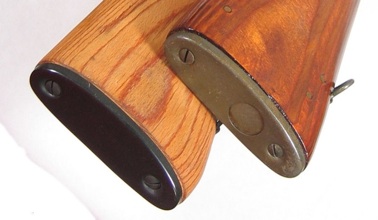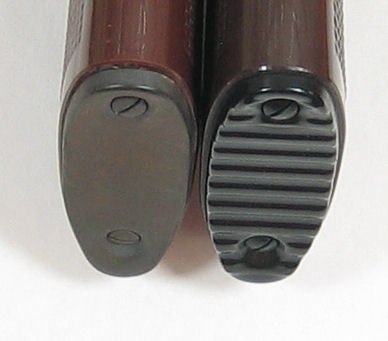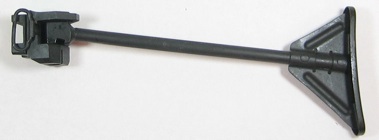Pure AK features

East German MPi-KM Fixed and MPi-KMS-72 Folding Buttstocks
Sunday, February 7, 2010

East German rifles had some of the most unique buttstocks among AK-pattern rifles. Fixed stock started with wood then went to plastic. While the East Germans never produced an underfolding AKMS-pattern rifle, they did produce a series of sidefolders.
As always, please let me know if you have identified other variations.
Copyright © 2010 Stephen Miles
The pebble-grain pattern of East German MPi-KM buttstocks is unique among AK-pattern rifles. (Image Source: Author)

AKM Pattern: These “red iodine” laminate buttstocks were used on AKM rifles first supplied to the NVA by the Soviets in 1961. Image is of a Soviet-supplied early-pattern laminate buttstock. (Image Source: Author)

Beech Laminate (1964-1966): Owing to a difference in availability of wood, East German laminate used beechwood instead of the Soviet-specified birch. This led to problems with the wood in extreme cold, and many beech laminate stocks required repair or replacement. (Image Source: Author)


Birch vs Beech Comparison: Unlike their Soviet counterparts, East German buttstocks did not have the trapdoor for a cleaning kit. Also, East German laminate is unique among all other nationalities because no nails are visible in the wood. (Image Source: Author)

MPi-KM Brown Plastic Pebble (1966-1990): Because of the problems with beech laminate, a desire to lighten the rifle’s weight, and seeking a reduction in manufacturing cost, a hard plastic buttstock was introduced during 1966. The characteristic pebble were intended to strengthen the buttstock. (Image Source: Author)
Date Codes: Most East German plastic buttstocks have a date code molded in the front right side, only visible when the buttstock is removed from the rifle. Early buttstocks had no codes. From at least 1968 to 1969, the two-digit month and last digit of the year were included. For example 12 and 8 would be “December 1968”. From 1970 onwards the last two digits of the year were molded. The image at right of 04 and 70 would be “April 1970”. By at least 1986 the position of the month and year moldings were switched. (Image Source: Dan Erik)
MPi-KM vs MPi-AK-74N Comparison: The East German AK-74 pattern buttstocks have a distinctive rippled baseplate. Note that the plastic mixture of MPi-KM buttstocks progressed from a reddish-brown to a chocolate-brown color over the period of production. (Image Source: Author)


S1 Crutch Sidefolder (1970-1973): The East Germans had many problems manufacturing their underfolding MPi-KmS milled AKS-pattern rifle. In order to simplify the design, and use a common reciever for fixed and
folding stock rifles, they designed the crutch sidefolder. This stock was seen as a great improvement by soldiers as the stock could be opened and shut using the only the thumb of the hand on the pistol grip, without having to leave a firing position. This stock never saw service with the NVA. Instead, every example was mated to 1970-1973 dated MPi-KM rifles, redesignated the “S-1”, and sent to the Egyptians where they were highly prized as an “elite” weapon. In October 1973, after the S1 rifles had their combat debut in the Yom Kippur war, the dies and tooling for making the crutch sidefolder were sent to Egypt. East German versions are discerned from Egyptian because they are blued instead of painted, and have a 1” sling loop instead of the larger 1 1/4”. (Image Source: Author)

MPi-KMS-72 Sidefolder (1972-1990): Using a similar mechanism to the S-1 sidefolder, but incorporating a stronger and more ergonomic stock design, East German MPi-KMS-72 sidefolders were introduced to NVA service in 1972. This design was later emulated by the Romanians and Polish. The East German MPi-AKS-74N (Bottom Right) and some other export rifles used a painted version with a larger sling loop. (Image Source: Author)

Black Pebble-Grain Plastic (1988-1990): A few export rifles were produced with a black plastic buttstock in the late 1980s. (Image Source: Internet)


